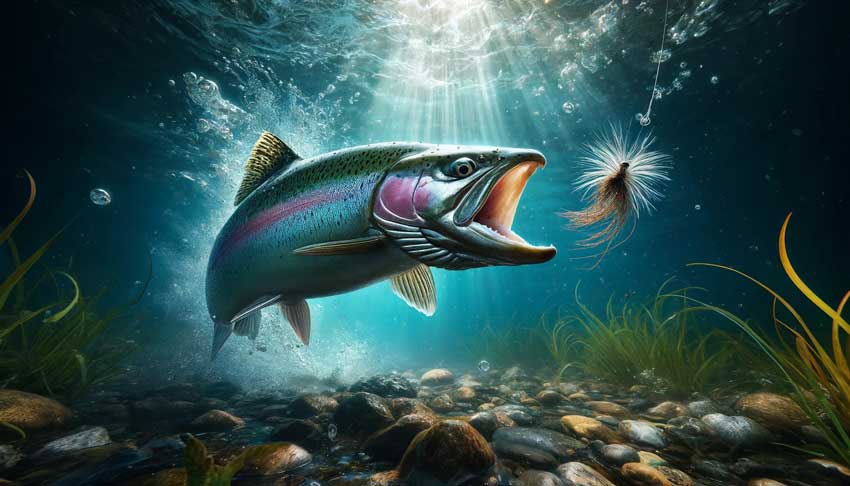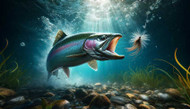Why You Should Use Leech Patterns in Winter: A Guide’s Perspective

As a professional fly fishing guide, I’ve spent countless days on the water during the colder months. Whether you're casting for trout in icy rivers, swinging for steelhead in the Pacific Northwest, or chasing bass and pan fish in the south, there’s one fly that consistently earns its spot in my winter box: the leech pattern.
Leeches are a year-round food source for many fish species, and their natural movement, profile, and protein-packed allure make them a top choice when conditions are tough, and fish are selective. Let me break down why leech patterns should be a go-to for trout, steelhead, and even saltwater flats fishing this winter.
Why Leeches Work in Winter
Winter presents unique challenges for fly anglers. Fish metabolisms slow in colder water, meaning they seek out meals that are calorie-rich and easy to capture. Leeches check both boxes.
These versatile creatures are present in freshwater and saltwater ecosystems year-round, making them a familiar and reliable food source. Their slow, undulating motion in the water mimics a struggling or drifting meal—perfect for lethargic fish waiting for the right opportunity to feed.
Leech Patterns for Trout
In winter, trout become more deliberate in their feeding habits, often favoring subsurface food sources like scuds, worms, and leeches. When insect activity slows down, a well-presented leech pattern can save the day.
Tips for Fishing Leech Patterns for Trout:
- Fish Slowly:
A leech’s movement is naturally slow, especially in cold water. Drift your fly under an indicator, or use a slow, steady retrieve. Dead-drifting with subtle twitches can be incredibly effective. - Vary Your Depths:
Trout in winter often hold in deep, slow-moving pools where water temperatures are slightly warmer. Use weighted leech patterns or sinking lines to reach them. - Experiment with Colors:
Black, olive, maroon, and brown leech patterns are staples, but don’t be afraid to try brighter options like purple or red when visibility is low. - Choose the Right Size:
Winter trout often key in on smaller food sources. While larger articulated leeches can be deadly, micro-leech patterns are sometimes the ticket, especially in highly pressured waters.
Leech Patterns for Steelhead
Winter steelhead are among the most sought-after and challenging game fish to catch. These fish, often referred to as "the fish of a thousand casts," can be notoriously picky in cold, high-water conditions. This is where leech patterns shine.
Why Leeches Work for Steelhead:
Steelhead are opportunistic feeders, even though they aren’t actively feeding during their spawning migration. Leeches, with their lifelike movement and enticing profile, provoke an aggressive response—either out of hunger or territorial instinct.
Tips for Fishing Leech Patterns for Steelhead:
- Swing Your Fly:
Steelhead are suckers for a well-swung fly. Use a Spey rod or single-handed setup with a sink tip to present your leech pattern at the right depth. Let it swing across the current, pausing to allow the fly to pulse in the water. - Focus on Color and Size:
Steelhead love bold colors. Black and purple are classic choices, but pink, chartreuse, and orange can also draw strikes. Larger, articulated leech patterns with a lot of movement are particularly effective for steelhead. - Adapt to Conditions:
In clear, low water, opt for smaller, sparser leeches. In murky, high-water conditions, go big and flashy. A weighted leech with a tungsten bead or conehead can help you reach the strike zone quickly. - Fish Holding Water:
Steelhead hold in deep pools, tailouts, and seams. Present your fly where they’re resting or staging, and be patient—it often takes multiple casts to coax a strike.
Leech Patterns for Bass and Pan Fish in the South
You might not think of leeches when casting in warm water ponds and lakes, but many warm water species—including bass, bluegill, catfish, and even walleye - feed on leeches and worms in the winter.
Tips for Warm Water Ponds and Lakes with Leech Patterns:
- Mimic Bottom-Dwelling Prey:
Flats fish are often tailing, rooting in the sand for worms and shrimp. A weighted leech pattern, like a Bunny Leech or v-worm imitation, can sink quickly and mimic prey burrowing into the substrate. - Match the Movement:
Use short, slow strips to mimic the undulating motion of a leech or marine worm. Let the fly settle between strips to make it look natural and vulnerable. - Choose Subtle Patterns:
In heavily fished areas, warm water species often reject flashy flies. Leech patterns with muted colors and natural movement can fool wary fish when nothing else works.
Leech Patterns You Should Carry
Whether you’re chasing trout, steelhead, or saltwater species, these leech patterns deserve a spot in your box:
- Woolly Bugger: The ultimate freshwater leech pattern, effective for trout, steelhead, and even bass.
- Jiggy and/or Mini Leech: Perfect for stillwater fish under an indicator.
- Stinger Hooked-Style Leeches: A favorite for steelhead, these large, articulated flies with lots of movement are hard to beat. (Trailer Trash or Fish Taco)
- Bunny Leech: With its lifelike rabbit-strip tail, it’s deadly in both fresh and saltwater.
- Saltwater Wiggler Patterns: Flies like the Wiggler, Gotcha and Bonefish Puff double as leech imitations, crabs and shrimp on the flats.
Final Thoughts
Leech patterns aren’t just a fallback—they’re often the best choice for winter fishing. Their year-round presence, natural movement, and high-calorie appeal make them irresistible to trout, steelhead, and warm water species alike.
As a guide, I’ve seen countless anglers light up when they hook into a fish that couldn’t resist a leech. Whether you’re dead-drifting for trout, swinging for steelhead, or stalking your local pond, leech patterns are your secret weapon this winter.
Tight lines!







